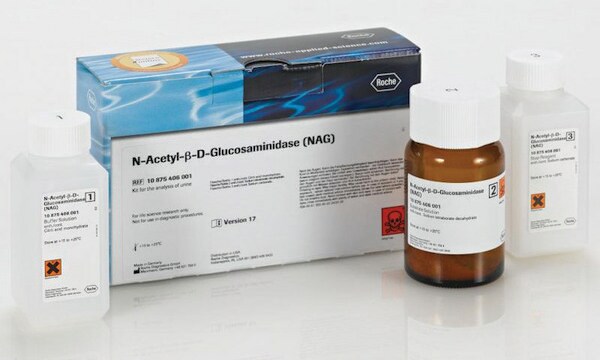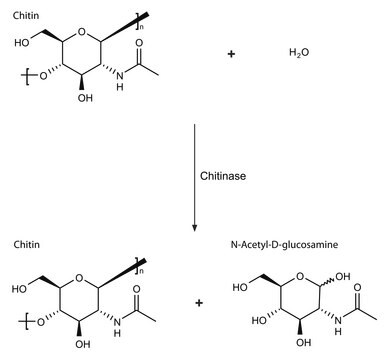MAK456
β-N-Acetylglucosaminidase Assay Kit
Sufficient for 100 colorimetric tests
Synonym(s):
NAG Activity Assay Kit
Sign Into View Organizational & Contract Pricing
All Photos(1)
About This Item
UNSPSC Code:
12161503
Recommended Products
Quality Level
detection method
colorimetric
relevant disease(s)
endocrinological disorders, diabetes; genitourinary disorders
storage temp.
−20°C
Related Categories
General description
β-N-Acetylglucosaminidase (NAG) is a lysosomal enzyme involved in a variety of biological processes such as the degradation of glycoproteins and glycolipids, cell proliferation, and signal transduction. NAG is found in many tissues in the body, but due to its high molecular weight, it cannot be filtered through the glomerular membrane. For this reason, in the presence of tubular damage or a glomerular lesion, urinary NAG activity increases. Elevated NAG levels in urine are an early indication of renal damage, such as injury due to diabetes mellitus, inflammation, nephritic syndrome, urinary tract infection, and more. Various forms of cancer have been associated with increased levels of NAG in serum. Genetically inherited lipid storage disorders, such as Tay-Sachs and Sandhoff disease, arise from deficiencies of the enzyme.
Application
- Anti-inflammatory activity of Protium spruceanum (Benth.) Engler is associated to immunomodulation and enzymes inhibition.: This research demonstrated the anti-inflammatory effects of Protium spruceanum, highlighting its ability to modulate immune responses and inhibit enzymes, including beta-N-Acetylglucosaminidase (Amparo et al., 2019).
- Toxicity study of oxalicumone A, derived from a marine-derived fungus Penicillium oxalicum, in cultured renal epithelial cells.: The study investigated the cytotoxic effects of oxalicumone A, employing beta-N-Acetylglucosaminidase assays to assess renal toxicity (Shi et al., 2017).
- Renal tubular dysfunction measured by N-acetyl-beta glucosaminidase/Creatinine activity index in children receiving antiepileptic drugs: a randomized controlled trial.: This trial assessed renal tubular dysfunction in children on antiepileptic drugs using the beta-N-Acetylglucosaminidase/Creatinine activity index, providing valuable data on drug safety (Mazaheri et al., 2011).
- Real-time polymerase chain reaction-based identification of bacteria in milk samples from bovine clinical mastitis with no growth in conventional culturing.: The application of beta-N-Acetylglucosaminidase assays in identifying bacterial infections in milk samples from bovine mastitis cases with negative conventional culture results was demonstrated in this study (Taponen et al., 2009).
The β-N-Acetylglucosaminidase Assay Kit may be used for:
Diabetes Research
Endocrinological Research
Genitourinary Disease Research
Diabetes Research
Endocrinological Research
Genitourinary Disease Research
Features and Benefits
Enhanced Sensitivity and Accuracy: Detect Beta-NAG levels ranging from 0.2 to 50 U/L in a 30 minute reaction with as little as 20 μL of sample, providing precise results.
Compatibility with High-Throughput Systems: Easily incorporate our kit into high-throughput handling systems, ensuring smooth and accurate processing, enhancing efficiency in your laboratory workflow.
Compatibility with High-Throughput Systems: Easily incorporate our kit into high-throughput handling systems, ensuring smooth and accurate processing, enhancing efficiency in your laboratory workflow.
Suitability
The kit is suitable for β-N Acetylglucosaminidase activity determination in urine, serum, plasma, cell lysate, etc.
Principle
The β-N-Acetylglucosaminidase Assay Kit is based on the cleavage of p-nitrophenol from a synthetic substrate. p-Nitrophenol becomes intensely colored after addition of the stop reagent. The increase in absorbance at A405 nm after addition of the stop reagent is directly proportional to the enzyme activity.
Other Notes
For additional information on our range of Biochemicals, please complete this form.
Signal Word
Warning
Hazard Statements
Precautionary Statements
Hazard Classifications
Eye Irrit. 2
Storage Class Code
12 - Non Combustible Liquids
WGK
WGK 1
Flash Point(F)
Not applicable
Flash Point(C)
Not applicable
Certificates of Analysis (COA)
Search for Certificates of Analysis (COA) by entering the products Lot/Batch Number. Lot and Batch Numbers can be found on a product’s label following the words ‘Lot’ or ‘Batch’.
Already Own This Product?
Find documentation for the products that you have recently purchased in the Document Library.
Our team of scientists has experience in all areas of research including Life Science, Material Science, Chemical Synthesis, Chromatography, Analytical and many others.
Contact Technical Service





